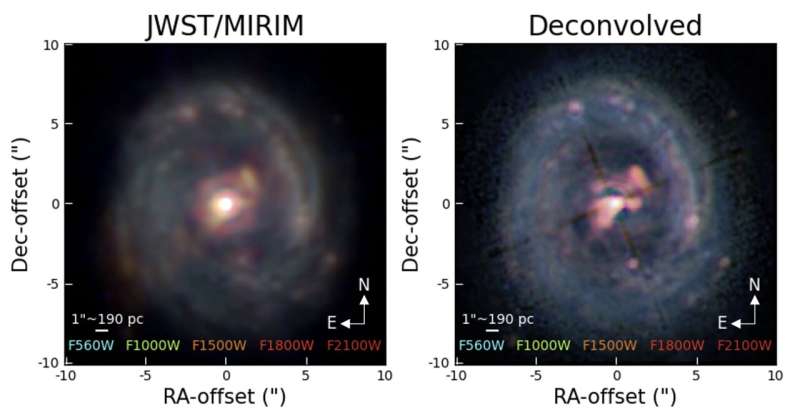This article has been reviewed according to Science X's editorial process and policies. Editors have highlighted the following attributes while ensuring the content's credibility:
fact-checked
peer-reviewed publication
trusted source
proofread
Researchers reveal faint features in galaxy NGC 5728 though JWST image techniques

Mason Leist is working remotely—127 million light-years from Earth—on images of a supermassive black hole in his office at the UTSA Department of Physics and Astronomy.
The UTSA Graduate Research Assistant has led a study, published on the arXiv preprint server and accepted for publication in The Astronomical Journal, on the best method to improve images obtained by the James Webb Science Telescope (JWST) using a mathematical approach called deconvolution. He was tasked by the Galactic Activity, Torus, and Outflow Survey (GATOS), an international team of scientists, to enhance JWST observations of the galaxy NGC 5728.
The GATOS team, co-led by UTSA Professor and Leist's doctoral advisor Chris Packham, was awarded time on the JWST for its research on black holes.
"It's incredibly humbling," Leist said. "Not just working with JWST data, which is a great opportunity and a crazy amount of science, but working with our collaborators. It's a very incredible experience to collaborate with other members of the GATOS on this. I like to tell people that this work represents the efforts of 35 individuals from institutes in 14 countries."
Leist deconvolved simulated and observed images of an active galactic nucleus (AGN), a region at the center of the galaxy NGC 5728. The central engine of an active galactic nucleus, composed of a hot and turbulent accretion disk orbiting a central supermassive black hole enshrouded by a thick torus of gas and dust, plays a key role in feedback between the AGN, host galaxy and intergalactic medium.
He tested five deconvolution algorithms over two years on simulated observations of an AGN. Of the five methods tested, the Kraken algorithm improved the simulated AGN model image quality the most and was therefore applied to JWST observations of NGC 5728. Kraken is a high-performance multi-frame deconvolution algorithm developed by a team of researchers led by Douglas Hope and Stuart Jefferies at Georgia State University.
JWST observed NGC 5728 at five distinct wavelengths. In these observations, a faint extended feature was seen in only one wavelength. As Leist deconvolved the data, the faint extended emission feature was revealed in all wavelengths, demonstrating the effectiveness of Kraken deconvolution to improve JWST image quality and enhance faint extended emission features.
"We believe the extension could be part of an outflow from a supermassive black hole that could be interacting with the host galaxy. There's a lot more science that needs to be done," Leist said. "It is difficult to distinguish the extended structure in all of the JWST images, but by using deconvolution techniques, we reduced the image data to reveal the hidden faint emission feature."
The process was also a collaboration with Willie Schaefer, UTSA's Adobe Creative Cloud support specialist, who helped create a scientifically accurate set of color images for the study.
Leist's work demonstrates that deconvolution is an efficient and accurate tool for image processing. Similar methods, he and Packham said, can be applied to broader science cases using JWST observations. The approach has garnered significant interest from fellow scientists working on JWST image processing.
"We're doing important work using JWST data," Packham said. "But it's important because we can improve on the raw data and get better image quality to see those fainter details by using this approach. It shows the strength of collaboration within the GATOS, which is co-led from UTSA."
Leist's work to enhance the JWST observations of the galaxy NGC 5728 is a new piece in the puzzle that further demystifies the origins of the universe. The full scope of the deconvolved images and other astrophysical results will be described in forthcoming studies currently underway by the GATOS.
"It goes back to the generation of galaxies shortly after the Big Bang," Packham explained. "If we really want to understand our place within our own galaxy, within our own solar system and within the universe in general, we have to understand what's going on within black holes in our galaxy and, indeed, other galaxies. We can understand the formation of our galaxy, our solar system, the Earth and life on Earth. It's really part of that big picture question."
More information: M. T. Leist et al, Deconvolution of JWST/MIRI Images: Applications to an AGN Model and GATOS Observations of NGC 5728, arXiv (2023). DOI: 10.48550/arxiv.2312.14307
Journal information: Astronomical Journal , arXiv
Provided by University of Texas at San Antonio




















